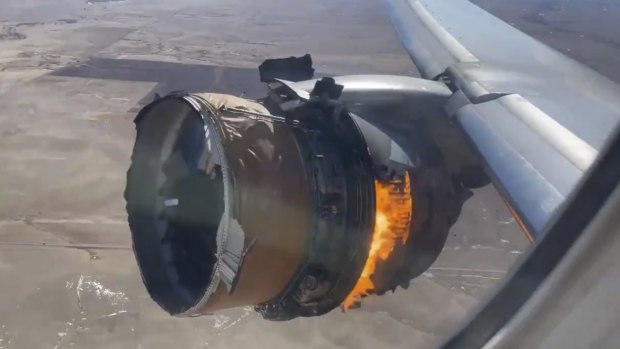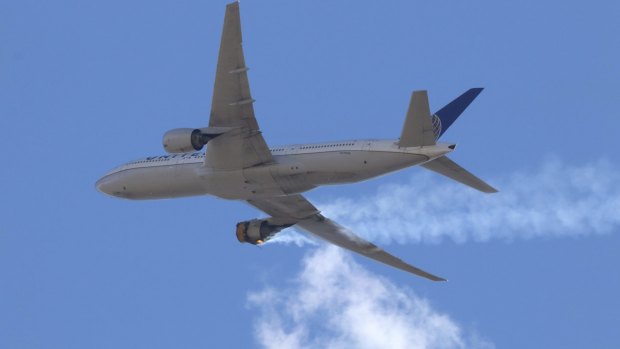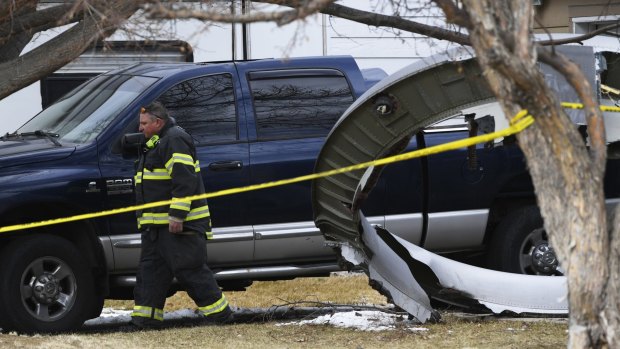This was published 3 years ago
United Airlines Boeing 777 flight 328 engine failure: What happens when an aircraft engine fails

The engine of United Airlines Flight 328 is on fire after after experiencing a 'right-engine failure' shortly after takeoff from Denver International Airport on February 20.Credit: Chad Schnell/AP
Over the weekend of 20-21 February, video on social media appeared showing a United Airlines Boeing 777 with an engine on fire and vibrating from side to side. Passengers on the starboard side got an instructional view of the innards of a jet engine as bits of the shattered turbofan fell away, raining down on Broomfield, Colorado, landing in the yards of surprised homeowners and narrowly missing the half-dozen teams at soccer practice on the city's Commons Park.
Happily for all, United Airlines flight 328 returned to Denver International Airport and landed safely, despite carrying a heavy fuel load for its intended flight to Hawaii, with no injuries to passengers, crew or those on the ground.
A preliminary assessment by the US National Transportation Safety Board pinned the blame on metal fatigue in a fan blade. Shortly after the aircraft took off from Denver, one of the engine's 22 fan blades broke off at the stem, shattering an adjacent blade and starting a chain of events that led to the engine fire.

United Airlines flight 328 returned to Denver International Airport and landed safely, despite carrying a heavy fuel load for its intended flight to Hawaii.Credit: Hayden Smith/AP
While the cowling, the metal skin that wraps around the entire engine, is designed to contain loose engine parts in such an eventuality, in this case the forces generated ruptured the cowling and engine components cascaded, an uncontained failure in aviation parlance.
Engine failures on commercial aircraft are rare, but frightening. In February 2018 another United Airlines Boeing 777-200 experienced a broken fan blade over the Pacific Ocean on a flight between San Francisco and Honolulu. In December 2020 two fan blades on a Japan Airlines 777-200 broke up shortly after the aircraft took off from Okinawa. On Friday, a 777 for Russian carrier Rossiya Airlines made an emergency landing in Moscow after an engine problem.
Video: United Airlines jet's engine fire

A firefighter walks past a large piece the United Airline plane's engine housing that fell in the suburbs of Denver.Credit: AP
While these incidents put yet another Boeing aircraft model under the safety spotlight, early investigations suggest that blame might lay with the engines. All these aircraft (with the exception of the the Rossiya aircraft, which had a General Electric engine) were fitted with engines from Pratt & Whitney. Boeing has since recommended that operators of its 777 aircraft suspend operations until the US Federal Aviation Administration has identified the problem.
Commercial airlines around the world have also grounded their 777s for the time being – but the grounding applies only to those fitted with Pratt & Whitney engines. United Airlines' Boeing 777s with GE engines and American Airlines 777s with GE and Rolls Royce airlines continue to operate.
Air New Zealand has a number of Boeing 777s in its fleet but these aircraft are currently stood down due to lack of current demand and won't return to service until at least September 2021. Virgin Australia's five 777s, which flew Australia-US routes, were retired last year after the airline's financial collapse, with the reborn airline focusing only on domestic travel for the foreseeable future.
In yet another episode that points the finger at this same engine, on the exact same day as the engine on United Airlines flight 328 disintegrated over Colorado, one of the engines on a Boeing 747 cargo aircraft flying over the Netherlands exploded, scattering parts across the ground. The engines on that aircraft were Pratt & Whitney PW4000s, a smaller version of the PW4700s on the United Airlines Boeing 777. One of the unique features of these engines is hollow fan blades. While engines made by other engine makers have also experienced blade failures inflight, expect investigators to zero in on those hollow blades.
The fire danger
A disintegrating engine can also catch fire, as happened in the case of UA328. A hot engine with loose metal flying around close to electrical wiring and highly combustible fuel and oil and abundant oxygen can be an explosive combination. Pilots are trained to deal with fires, and even though an engine in flames might look spectacular or terrifying, depending on whether you're seeing it online or out the window of an aircraft, they rarely result in a crash.
Jet aircraft engines are fitted with fire detection and extinguishing systems. When fire in the engine is detected, extinguishers release Halon 1301 or hydrofluorocompounds, the flight crew shuts down the engine and stops fuel and hydraulic fluid flowing to the engine.
One such incident that received wide coverage in Australian media occurred in 2010 when one of the engines on a Qantas A380 en route to London caught fire four minutes after takeoff from Singapore's Changi Airport. The fire caused a turbine disc to break away from the engine's drive shaft and the disc burst the engine cowling, showering debris on the Indonesian island of Batam.
Despite damage to control surfaces, the crew flew the aircraft in a holding pattern for almost two hours while they assessed the situation and grappled with the technicalities of landing an aircraft 50 tonnes over Changi Airport's maximum landing weight. The heavy landing blew several tyres but Captain Richard Champion de Crespigny and his crew were lauded for their cool-headed performance. An investigation by the Australian Transport Safety Bureau concluded that metal fatigue in a non-compliant oil feed pipe caused the pipe to rupture, leaking hot oil and causing the fire.
The most famous aircraft fire since the conflagration that destroyed the German airship Hindenburg was the one that brought down the Air France Concorde in 2000. A piece of metal debris from a Continental Airlines DC-10 that had taken off just five minutes before shredded one of the tyres on the Concorde as it was accelerating for take-off. A chunk of tyre smashed into the underside of the aircraft's left wing, causing a shock wave which ruptured one of the Concorde's 17 fuel tanks.
A spark ignited the fuel as it gushed from the tank and the aircraft took off trailing a plume of fire. With one of its four engines out of action and flames engulfing the fuselage, the Concorde banked and stalled as the crew throttled back the remaining engines in an attempt to level the aircraft, barely travelling beyond the airport before it crashed into an almost vacant hotel, killing all on board. Investigators found that a confluence of one-in-a-million factors contributed to the fire and subsequent crash, one of the reasons the era of supersonic passenger flight ended shortly afterwards.
See also: 'COVID-19 has terminated my career': Hero of A380 flight QF32 grounded
Sign up for the Traveller newsletter
The latest travel news, tips and inspiration delivered to your inbox. Sign up now.